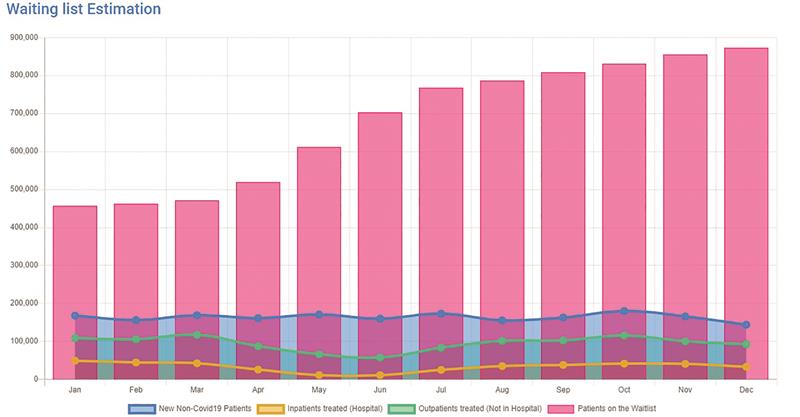
Hospital Waiting Times
The temporary suspension of most clinical services during the initial response to the Covid-19 pandemic has left many worrying about the extent of the back log and the impact this will have upon future waiting times for patients. Last week saw the launch of a useful waiting list estimate tool from the company Medbelle, a company who describe themselves as ‘the UK’s first digital hospital’. You can access the tool at www.medbelle.com/waitlist and, by inputting the clinical discipline and hospital area, easily calculate the estimated waiting times whether there be full capacity, reduced capacity or a second infection peak post-lockdown. Figure 1 shows my results for ophthalmology services. One startling prediction is a more than doubling in ophthalmology waiting times if a second Covid outbreak arrives.
 Figure 1: Ophthalmology appointment waiting times predicted by a new online tool from Medbelle
Figure 1: Ophthalmology appointment waiting times predicted by a new online tool from Medbelle
Social distancing
Just as our PM was suggesting his hope for reducing social distancing rules, an excellent and important review paper was released that cast doubt over his fantasising.1 The study by Chu et al, funded by the World Health Organisation, was a comprehensive review and meta-analysis of some 172 observational studies across 16 countries and six continents which looked at the impact of social distancing and face and eye protection in limiting the spread of Covid-19 infection. The main findings were as follows:
- Transmission of viruses was lower with physical distancing of 1m or more, compared with a distance of less than 1m. This amounted to a reduction in risk of 82% when maintaining a physical distance of 1m in both health care and community settings.
- Protection was increased as social distance was lengthened – every additional metre of separation more than doubled the relative protection (with data available up to 3m).
- Use of face masks and respirators reduced the risk of infection by 85%, an effect that was greater in healthcare settings than in the community at large. This is due to the predominant use of N95 respirators in the former. In a sub-analysis, respirators were found to be 96% effective compared with other masks, which were 67% effective.
- Eye protection resulted in a 78% reduction in infection.
As we all plan our return to patient assessment, these findings are important. They also cast doubt over any temptation to relax social distancing. As The Lancet points out in its editorial comment on the paper,2 ‘until randomised controlled trial data are available, this study provides the best specific evidence for Covid-19 prevention.’
Skin Reactions
I am sure I am not alone in finding the long-term wearing of face masks as both uncomfortable and irritating to my sensitive Irish skin. An interesting new study3 has looked at short-term skin reactions following use of N95 respirators and medical masks. To be clear, a surgical mask is a loose-fitting, disposable device that creates a physical barrier between the mouth and nose of the wearer and potential contaminants in the immediate environment. These are often referred to as face masks, although not all face masks are regulated as surgical masks, and the edges of the mask are not designed to form a seal around the nose and mouth. An N95 respirator is a respiratory protective device designed to achieve a very close facial fit and very efficient filtration of airborne particles. Their edges are designed to form a seal around the nose and mouth. Surgical N95 respirators are more commonly used in healthcare settings and are a subset of N95 Filtering Facepiece Respirators (FFRs), often referred to more simply as N95s.
Perhaps not too surprisingly, the study found that ‘N95 respirators were associated with more skin reactions than medical masks,’ typically contact dermatitis. Some useful hints at alleviating the problem were offered by dermatologists in another new paper,4 namely:
- Facial PPE should be adjusted to fit correctly and should not lead to excess pressure or discomfort on any one particular area of the face.
- Skin should be routinely cleaned and moisturised using non-comedogenic (will not clog up pores) emollients at least one hour before donning facial PPE.
- Petrolatum-based products (Vaseline, for example) are not recommended as a skin sealing or repair agents as they may interfere with the integrity of the mask.
Obesity
Evidence, on top of the obvious geographical, continues to grow showing a link between obesity and Covid disease severity, this week from a major US study.5
Treatment
The team at Oxford undertaking the Recovery treatment trials, announced this week, ‘We have concluded that there is no beneficial effect of hydroxychloroquine in patients hospitalised with Covid-19.’ I believe them.
